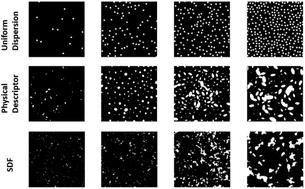当前位置:
X-MOL 学术
›
Mol. Syst. Des. Eng.
›
论文详情
Our official English website, www.x-mol.net, welcomes your feedback! (Note: you will need to create a separate account there.)
Mining structure–property relationships in polymer nanocomposites using data driven finite element analysis and multi-task convolutional neural networks
Molecular Systems Design & Engineering ( IF 3.6 ) Pub Date : 2020-04-01 , DOI: 10.1039/d0me00020e Yixing Wang 1, 2, 3, 4 , Min Zhang 4, 5, 6, 7 , Anqi Lin 4, 5, 6, 7 , Akshay Iyer 1, 2, 3, 4 , Aditya Shanker Prasad 4, 8, 9, 10 , Xiaolin Li 2, 3, 4, 11 , Yichi Zhang 1, 2, 3, 4 , Linda S. Schadler 4, 12, 13, 14 , Wei Chen 1, 2, 3, 4 , L. Catherine Brinson 4, 5, 6, 7
Molecular Systems Design & Engineering ( IF 3.6 ) Pub Date : 2020-04-01 , DOI: 10.1039/d0me00020e Yixing Wang 1, 2, 3, 4 , Min Zhang 4, 5, 6, 7 , Anqi Lin 4, 5, 6, 7 , Akshay Iyer 1, 2, 3, 4 , Aditya Shanker Prasad 4, 8, 9, 10 , Xiaolin Li 2, 3, 4, 11 , Yichi Zhang 1, 2, 3, 4 , Linda S. Schadler 4, 12, 13, 14 , Wei Chen 1, 2, 3, 4 , L. Catherine Brinson 4, 5, 6, 7
Affiliation

|
Data-driven methods have attracted increasingly more attention in materials research since the advent of the material genome initiative. The combination of materials science with computer science, statistics, and data-driven methods aims to expediate materials research and applications and can utilize both new and archived research data. In this paper, we present a data driven and deep learning approach that builds a portion of the structure–property relationship for polymer nanocomposites. Analysis of archived experimental data motivates development of a computational model which allows demonstration of the approach and gives flexibility to sufficiently explore a wide range of structures. Taking advantage of microstructure reconstruction methods and finite element simulations, we first explore qualitative relationships between microstructure descriptors and mechanical properties, resulting in new findings regarding the interplay of interphase, volume fraction and dispersion. Then we present a novel deep learning approach that combines convolutional neural networks with multi-task learning for building quantitative correlations between microstructures and property values. The performance of the model is compared with other state-of-the-art strategies including two-point statistics and structure descriptor-based approaches. Lastly, the interpretation of the deep learning model is investigated to show that the model is able to capture physical understandings while learning.
中文翻译:

使用数据驱动的有限元分析和多任务卷积神经网络挖掘聚合物纳米复合材料的结构-性质关系
自从材料基因组计划问世以来,数据驱动方法在材料研究中吸引了越来越多的关注。材料科学与计算机科学,统计和数据驱动方法的结合旨在加速材料研究和应用,并且可以利用新的和存档的研究数据。在本文中,我们提出了一种数据驱动的深度学习方法,该方法建立了聚合物纳米复合材料的部分结构与属性的关系。对已归档的实验数据的分析促进了计算模型的开发,该计算模型可以演示该方法,并为充分探索各种结构提供了灵活性。利用微结构重建方法和有限元模拟,我们首先探讨了微观结构描述符与力学性能之间的定性关系,从而得出了有关相间,体积分数和分散度相互作用的新发现。然后,我们提出了一种新颖的深度学习方法,该方法将卷积神经网络与多任务学习相结合,以建立微观结构和属性值之间的定量关联。该模型的性能与其他先进的策略进行了比较,这些策略包括两点统计和基于结构描述符的方法。最后,研究了深度学习模型的解释,以表明该模型能够在学习时捕获身体的理解。然后,我们提出了一种新颖的深度学习方法,该方法将卷积神经网络与多任务学习相结合,以建立微观结构和属性值之间的定量关联。该模型的性能与其他最新策略进行了比较,包括两点统计和基于结构描述符的方法。最后,研究了深度学习模型的解释,以表明该模型能够在学习时捕获身体的理解。然后,我们提出了一种新颖的深度学习方法,该方法将卷积神经网络与多任务学习相结合,以建立微观结构和属性值之间的定量关联。该模型的性能与其他先进的策略进行了比较,这些策略包括两点统计和基于结构描述符的方法。最后,研究了深度学习模型的解释,以表明该模型能够在学习时捕获身体的理解。
更新日期:2020-04-01
中文翻译:

使用数据驱动的有限元分析和多任务卷积神经网络挖掘聚合物纳米复合材料的结构-性质关系
自从材料基因组计划问世以来,数据驱动方法在材料研究中吸引了越来越多的关注。材料科学与计算机科学,统计和数据驱动方法的结合旨在加速材料研究和应用,并且可以利用新的和存档的研究数据。在本文中,我们提出了一种数据驱动的深度学习方法,该方法建立了聚合物纳米复合材料的部分结构与属性的关系。对已归档的实验数据的分析促进了计算模型的开发,该计算模型可以演示该方法,并为充分探索各种结构提供了灵活性。利用微结构重建方法和有限元模拟,我们首先探讨了微观结构描述符与力学性能之间的定性关系,从而得出了有关相间,体积分数和分散度相互作用的新发现。然后,我们提出了一种新颖的深度学习方法,该方法将卷积神经网络与多任务学习相结合,以建立微观结构和属性值之间的定量关联。该模型的性能与其他先进的策略进行了比较,这些策略包括两点统计和基于结构描述符的方法。最后,研究了深度学习模型的解释,以表明该模型能够在学习时捕获身体的理解。然后,我们提出了一种新颖的深度学习方法,该方法将卷积神经网络与多任务学习相结合,以建立微观结构和属性值之间的定量关联。该模型的性能与其他最新策略进行了比较,包括两点统计和基于结构描述符的方法。最后,研究了深度学习模型的解释,以表明该模型能够在学习时捕获身体的理解。然后,我们提出了一种新颖的深度学习方法,该方法将卷积神经网络与多任务学习相结合,以建立微观结构和属性值之间的定量关联。该模型的性能与其他先进的策略进行了比较,这些策略包括两点统计和基于结构描述符的方法。最后,研究了深度学习模型的解释,以表明该模型能够在学习时捕获身体的理解。



























 京公网安备 11010802027423号
京公网安备 11010802027423号